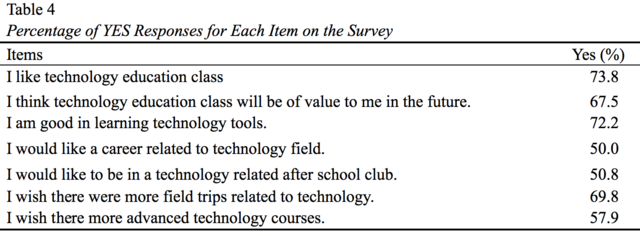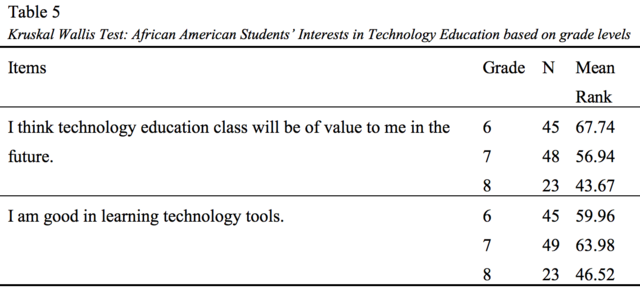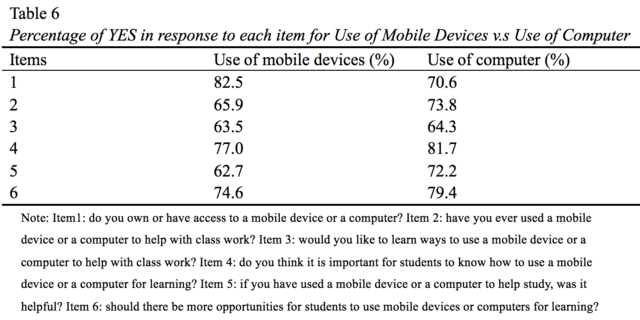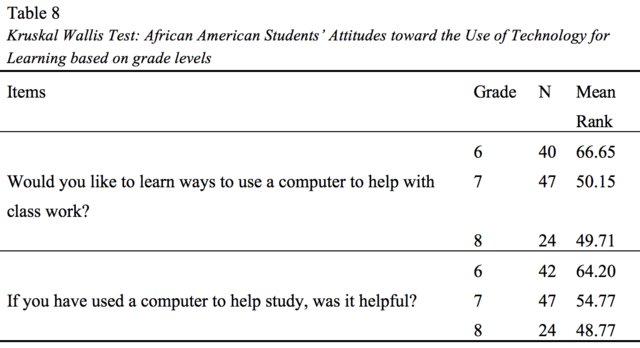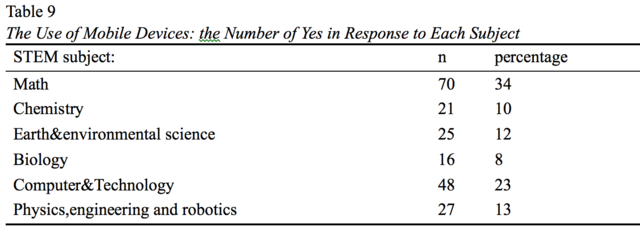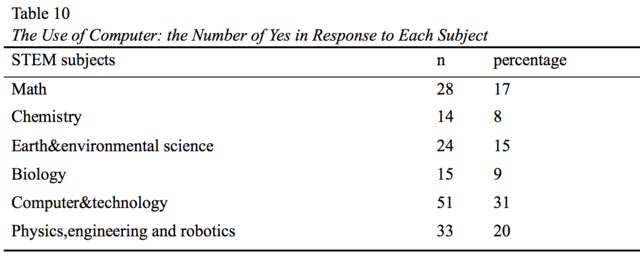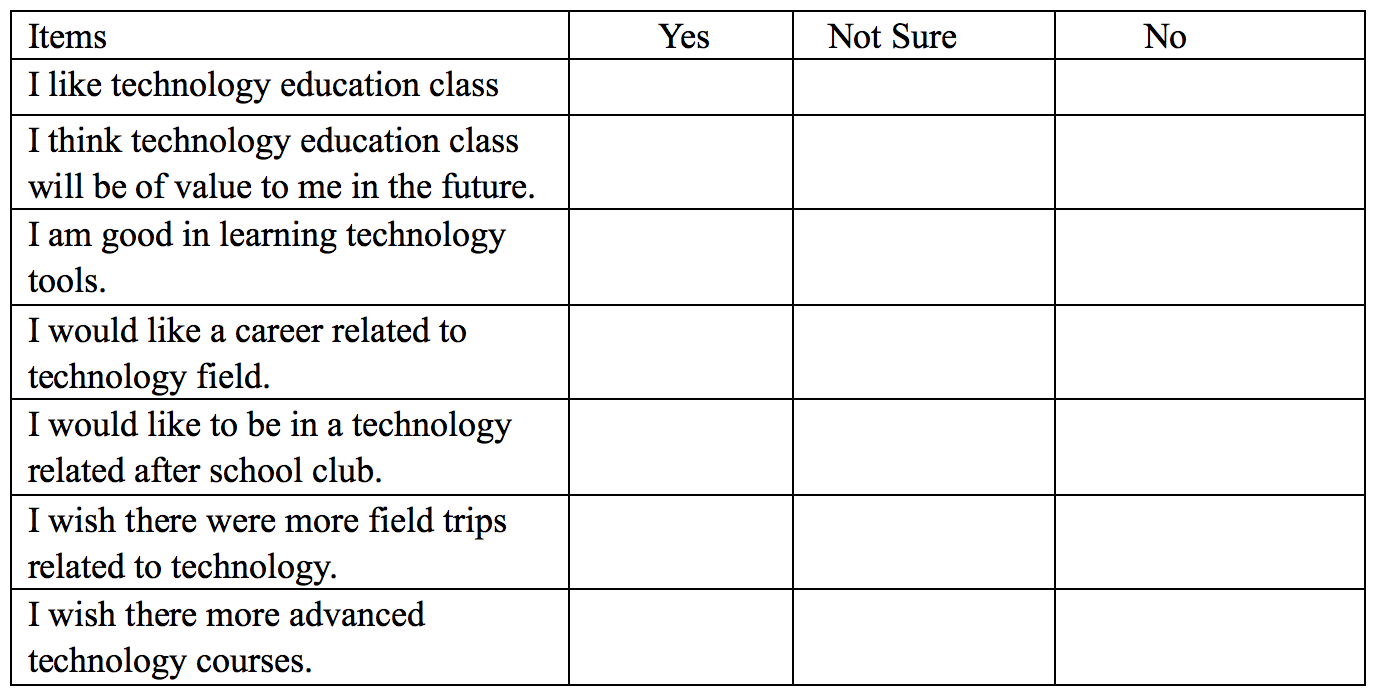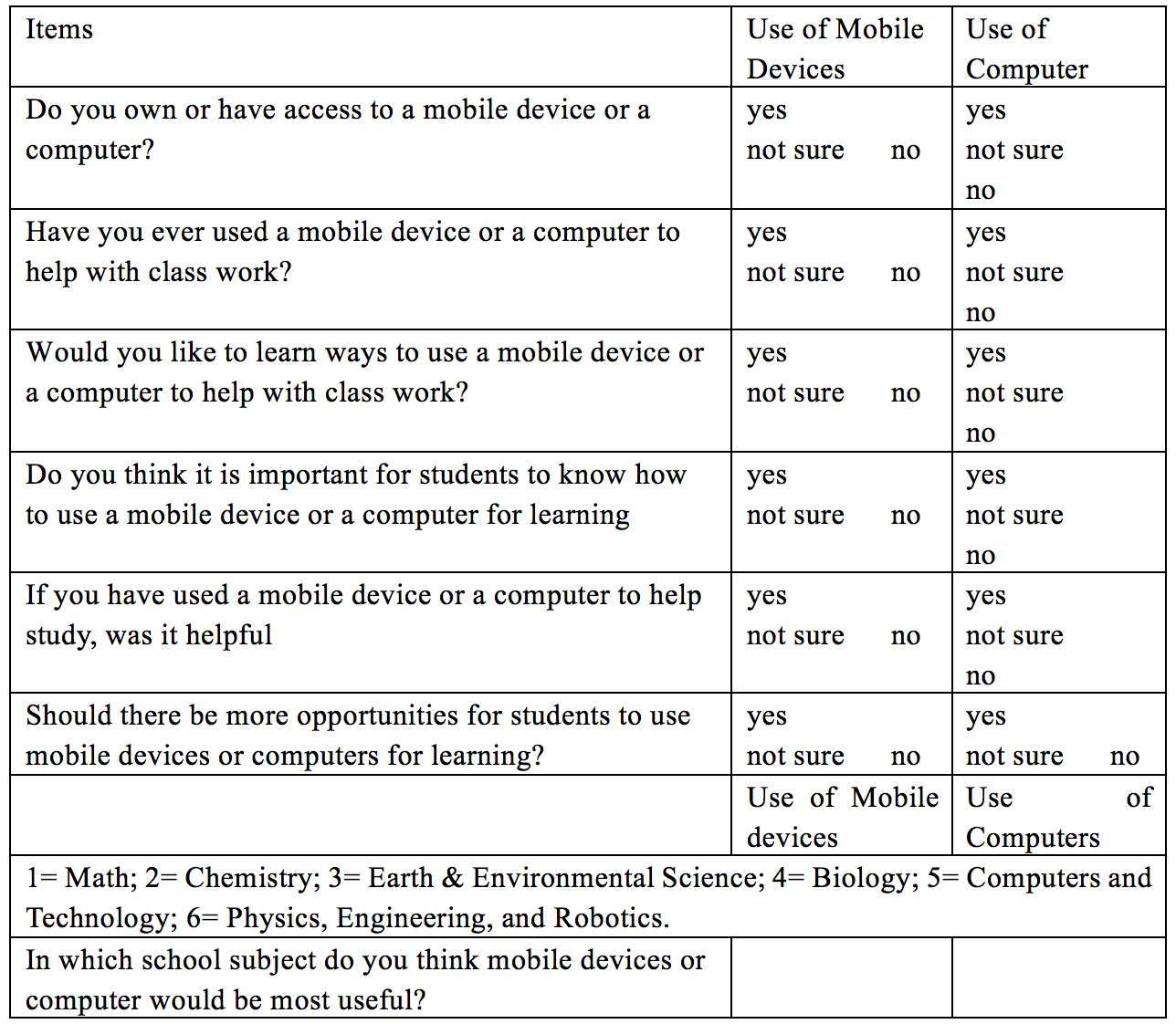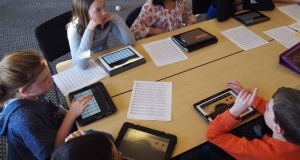Utilizing Technology for Learning STEM Subjects: Perceptions of Urban African-American Middle School StudentsResultsThe results of this study are presented for the demographics of the respondents and separately for each research question. DemographicsA total of 150 usable surveys were returned, 124 were answered by African-American students. As presented in Table 3, for African-American students, the number of responses between boys (n = 61) and girls (n = 63) was approximately equal. Regarding grade, the survey respondents were mostly in the sixth grade (boys: n = 25, 41%; girls: n = 25, 39.7%) and the seventh grade (boys: n = 23, 37.7%; girls: n = 28, 44.4%). The age range of the participants focused between 11 to 13 years old for both boys and girls. 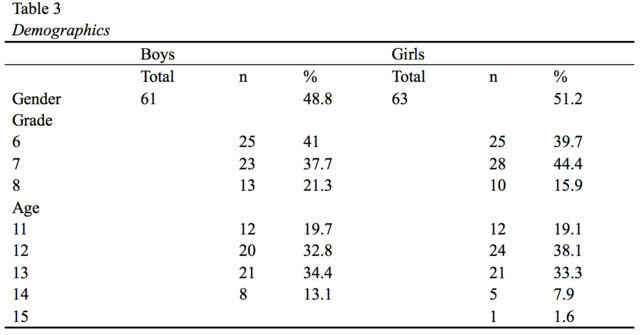
Research Question 1Table 4 shows the results of general information gathered from African-American students’ perspectives on technology. Most of the respondents (73.8%) were interested in technology education class and felt they were good in using technology tools (72.2%). About half of them would like to pursue careers related to technology field (50%) and participate in technology related after-school clubs (58%). Research Question 2Mitts and Haynie (2010) suggested that differences existed between boys and girls in their preferences for technology education. According to Mitts and Haynie’s study, middle school girls preferred technology activities that focused on design or communication that had social significance, whereas boys had a preference for “utilizing-type” activities. In order to examine gender differences in attitudes towards technology education, African-American students’ total scores in the section of interests in technology education classes were collected and compared using the Mann Whitney U test. The results of Mann Whitney U test for the overall attitude score of boys and the overall attitude score of girls towards technology education did not show any statistical difference (U = 1750.5; p = .681 > .05). The rank average of boys’ score is 62.33, while girls had a score rank average of 59.73. The close rank averages of scores between African-American boys and African-American girls indicate that they had somewhat equal preferences for technology education. Research Question 3To examine grade level differences in attitudes towards technology, a Kruskal-Wallis H test was used to analyze whether African-American students’ overall scores in the section of interests in technology education were differed among grade 6, grade 7, and grade 8. Although no significant differences were found in the section of interests in technology education, χ2 (2) = 2.006, p = .367, further analysis regarding their attitudes toward each survey item revealed that their attitudes differed significantly toward the item “I think technology education class will be of value to me in the future,” χ2 (2) = 12.495, p = .002, with a mean rank attitude score of 67.74 for grade 6, 56.94 for grade 7 and 43.67 for grade 8 (table 5). They held different attitudes toward the item “I am good in learning technology tools,” χ2 (2) = 7.194, p = .027, with a mean rank attitude score of 59.96 for grade 6, 63.98 for grade 7 and 46.52 for grade 8 (table 5). Research Question 4Table 6 presents results for items related to respondents’ views and experiences with mobile devices in comparison to computers. These data show that most of the students owned mobile devices (82.5%) and computers (70.6%). More students have used computers (73.8%) to help with their classwork than have used mobile devices (65.9%). Over 70% of students believed that it was important to know how to use technology to help with their class work and therefore wished more opportunities to use technology for learning. Research Question 5To examine gender differences in attitudes towards the use of technology for learning with comparison of mobile devices and computers, the results of Mann Whitney U test for the total score of African-American boys and the total score of African-American girls in the section of the use of technology for learning did not show any statistical difference, computer use for learning, U = 1590; p = .204; mobile devices use for learning, U = 1518, p = .101. Although no significant differences were found based on their overall scores in the section of the use of technology for learning, further analysis regarding African-American students’ attitudes toward each survey item revealed that their attitudes differed significantly toward the item “would you like to learn ways to use a computer to help with class work,” U = 1223.5, p = .019 < .05, with a mean rank attitude score of 61.54 for boys and 50.16 for girls (table 7). Students held different attitudes toward the item “if you have used a computer to help study, was it helpful,” U = 1511, p = .500, with a mean rank attitude score of 55.48 for boys and 58.49 for girls (table 7). Research Question 6To examine grade level differences in attitudes towards the use of technology with comparison of mobile devices and computers, no significant differences were identified among grade 6, grade 7 and grade 8 according to African-American students’ overall scores for the section of computer use for learning and the section of mobile devices use for learning, with regard to the overall six items. However, further analysis regarding their attitudes toward each survey item indicated that their attitudes differed significantly toward the item “would you like to learn ways to use a computer to help with class work,” χ2 (2) = 10.83, p = .004 < . 05, with a mean rank score of 66.65 for grade 6, 50.15 for grade 7 and 49.71 for grade 8 (table 8). Students held different attitudes toward the item “if you have used a computer to help study, was it helpful,” χ2 (2) = 7.180, p = .028 < .05, with a mean rank score of 64.20 for grade 6, 54.77 for grade 7 and 48.77 for grade 8 (table 8). Research Question 7Tables 9 and 10 present results concerning students’ beliefs and preferences for technology in different STEM subjects. Most respondents (n=70) thought that the mobile devices was helpful in math course, and some of them preferred computer (n=51) to help with their computer & technology course. Few respondents believed that the mobile devices (n=16; n=21) and computer (n=15; n=14) would be useful in biology or chemistry. Compared to the use of computers, mobile devices are relatively more popular for these students in STEM subjects.
DiscussionThe purpose of this study was to gain insight into African American middle school students’ level of access to technology and their perceived value and interests in technology education and the utilization of technology for learning, particularly in STEM areas. The participants in the study were students enrolled in a STEM-focused, Title I urban, middle school in the south central Louisiana. Limitations of the StudyThe results of our study must be interpreted within the limitations and delimitations of the inquiry. This research is based on data collected from an urban charter school in one state within the United States. The sample size is small; consequently the result of current research may not be the representative for the African American population in other areas. Albeit this survey investigation was conducted during students’ participation in Louisiana STEM expo, their response rate is rather low. Though the instrument used in this research is considered both valid and reliable (Mahoney, 2009), the modified instrument provided only the internal consistency reliability of the measure. In light of these boundaries, this study has resulted in several interesting findings. Key FindingsThe results for research questions 1 to 3 provide information about African-American students’ interests and attitudes toward technology in the curriculum and technology related-clubs and field trips. From the percentage of YES responses for these items, it is clear that the majorities of the respondents are interested in technology related courses and field trips. Although research reveals that the technology gap becomes wide particularly between Caucasian and African American children (Jackson et al., 2008), this result suggests African American children are confident in learning technology literacy. Boys and girls are generally equally enthusiastic about technology related activities and programs. Younger African American children seem to feel that technology education is more important to them and they value technology related classes in and out of school according to their responses in the survey. This finding is important, since current research pays more attention on the role of gender and race in terms of technology education (Jackson et al., 2008; KAHVECI, 2010; Ritzhaupt et al., 2013), little research has investigated their age and its relationship to educational technology and its related topics, particularly for African American population. The results for research questions 4 to 6 provide information about today’s African American middle school students’ learning environment associated with technology (e.g., mobile devices and computers) and their motivation for using technology for learning purposes. In this study, the high percentage of YES responses showed that most of African-American students at this school owned or had access to both mobile devices and computers, although they expressed a preference for using computers to help with school assignments. Most African-American students in this urban school have access to technology devices, either in the school or at home. This finding is interesting, because prior research shows the disparity in access to technology for minority groups, particularly African American children (Fairlie, 2012; Hesseldahl, 2008; Jackson et al., 2008; Ritzhaupt et al., 2013). The results of the current study also reveals that African-American boys are more willing to learn how to use computers to help with their class work than was true of African-American girls. Corresponding to Goldstein and Puntambekar (2004), given the alternative technology that assist with their classwork, boys were greatly motivated to learn through computer than girls. Girls were less confident in using computers. However, the result also indicates that African-American girls believe it is more meaningful to use a computer to help study. Corresponding to prior research, African American males were less likely to meaningfully use ICT resources when compared to their African American female counterparts (Jackson et al., 2008). Another interesting finding is that younger African American children have strong tendency to do class work through computers and they believe that it is beneficial when using computers to help study. Previous research showed students’ motivation to use technology for learning varied by personal characteristics such as gender, grade level, at high school level (KAHVECI, 2010). Little research has examined the effects of grade levels on the way students chose to learn at the middle school level. Nevertheless, this study suggests that students in lower grades tended to have more satisfaction in using technology compared to the higher graders, in African American groups. Younger children expressed greater enthusiasm for learning with technology. The results for research question 7 indicate that these students felt that mobile devices would be most useful in mathematics. Similarly, they felt that computers would be useful in computer science and technology related courses. In addition, few respondents advocated the use of technology in biology and chemistry. It was not clear from this survey why the respondents felt that mobile devices would be especially useful in math and why they were less likely to use technology in biology and chemistry.Continued on Next Page » Suggested Reading from Inquiries Journal
Inquiries Journal provides undergraduate and graduate students around the world a platform for the wide dissemination of academic work over a range of core disciplines. Representing the work of students from hundreds of institutions around the globe, Inquiries Journal's large database of academic articles is completely free. Learn more | Blog | Submit Latest in Education |

